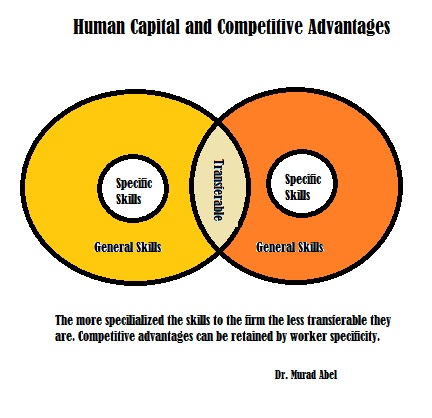Organizations seek to develop uniqueness that will
allow them to create competitive advantages that allow them to better compete
on international markets. The combination of human capital and organizational
factors helps develop those firm specific qualities. The development of human
capital through firm-specific skills will further retain the talent of
organizational members and encourage lower levels of knowledge loss or
competitive posturing.
Competitive advantage is a unique organizational strength
a company develops over competitors through the offering of higher products,
value, or benefits that justifies higher prices on the market. It is a
condition whereby an organization is more efficient and productive than those it
competes with. Such firms are seen as competitive, “if it is able to create more economic value than the marginal
competitor (Peteraf & Barney, 2003: 314). Through this competitiveness,
additional benefits are earned by the organization that other companies have a
hard time emulating.
Competitive advantage can be found in the
development of human capital within an organization. Such competitive advantage
comes from employee skills and abilities that cannot be easily passed from one
firm to another (Kor & Leblebici, 2005). Thus skills and abilities help
employees work in patterns and methods that other organizations will have
difficulty time copying without copying all of the unique aspects of the firm.
Skills and abilities can be developed within other
organizations which reduces the overall competitiveness of the subject firm.
However, even though such skills apply to other firms their true value lies in
their combination of technology, product markets and assets (Teece, 1986). Such
firms are able to combine the various components that create uniqueness in
order to develop new market strengths. It is this combination of strengths that
is difficult for organizations to develop without significant research, cost
and energy.
To develop competitive advantage through human
capital it is important to see employee skills as a total portfolio that
fosters firm strength. Some skills are general while others are more firm
specific (Lazear, 2009). It is the firm specific skills that have the highest
value and exchange rate with the organization. It is through the development of
employee skill specificity that organizations can not only create competitive
advantages in human capital but also the ability to retain such capital due to
its value being tied to the firm.
Let us take an example. Two employees are seeking
higher paychecks. Each has their own particular portfolio of skills and
abilities. The organization that understands the unique skills and abilities of
their employees can combine other assets to drive higher levels of unique
competitive advantages. In this example, employee 1 has skills that are unique
to the firm while employee 2 has skills that are more general. Employee 1 is
likely to be retained by the firm because their skills are non-transferrable.
Employee 2 can apply their skills wherever they decide to work and are more
likely to move to another company.
Firm specific capital is difficult to transfer to
other companies (Hashimoto, 1981). The more specialized the employee and their
abilities the less opportunity they have to move to a competitor and obtain comparative
wages and income. This specialization makes their value worth more to the home
firm where they are likely to be paid the highest rate of income.
Developing competitive advantages means combining
the organizations unique qualities with available human capital to develop
strengths that other firms cannot copy. Organizations that develop specific
firm related skills are less likely to lose this intellectual capital to other
companies that do not have the same needs. General skills provide appropriate
foundations for human capital development but can be easily transferred from
one firm to the next. Employees will also desire to retain employment as their
firm specific skills have the highest exchange rates of value. To develop
stronger competitive advantages requires the ability to take general skills and
foster firm specific skills that have the highest competitive advantage for
both the employee and the company by retaining employment.
Hashimoto, M. (1981). Firm-specific human capital as
a shared investment. American Economic
Review, 71: 475–482.
Kor, Y. & Leblebici, H. (2005). How do
interdependencies among human-capital deployment, development, and diversification
strategies affect firms’ financial performance? Strategic Management Journal, 26: 967–985.
Lazear, E. (2009). Firm-specific human capital: A
skill weights approach. Journal of
Political Economy, 117: 914-990.
Peteraf, M. & Barney, J. (2003). Unraveling the
resource based tangle. Managerial and
Decision Economics, 24: 309–323.
Teece, D. (1986). Profiting from technological
innovation: Implications for integration, collaboration, licensing and public
policy. Research Policy, 15: 285–305.
Bookmark with Your Social Network
